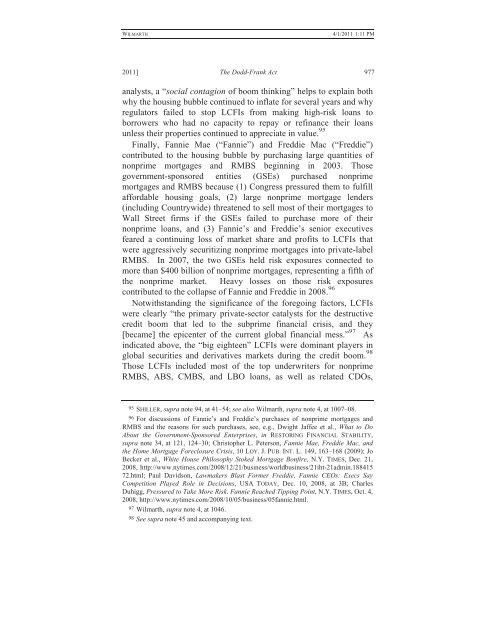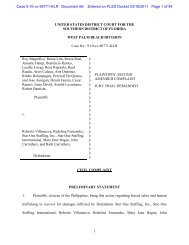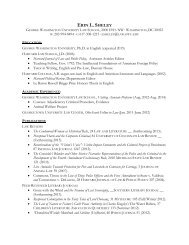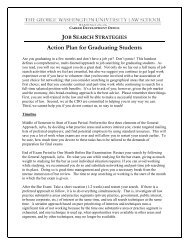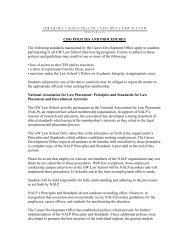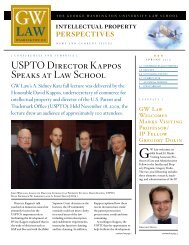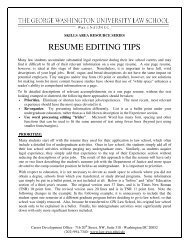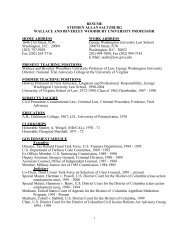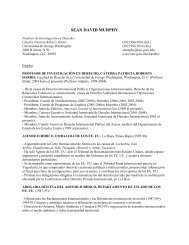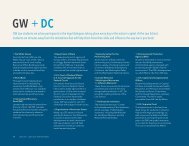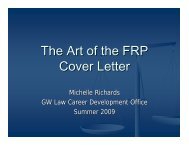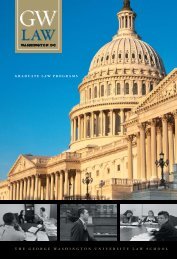CLE Materials for Panel #1 - George Washington University Law ...
CLE Materials for Panel #1 - George Washington University Law ...
CLE Materials for Panel #1 - George Washington University Law ...
You also want an ePaper? Increase the reach of your titles
YUMPU automatically turns print PDFs into web optimized ePapers that Google loves.
WILMARTH<br />
4/1/2011 1:11 PM<br />
2011] The Dodd-Frank Act 977<br />
analysts, a “social contagion of boom thinking” helps to explain both<br />
why the housing bubble continued to inflate <strong>for</strong> several years and why<br />
regulators failed to stop LCFIs from making high-risk loans to<br />
borrowers who had no capacity to repay or refinance their loans<br />
unless their properties continued to appreciate in value. 95<br />
Finally, Fannie Mae (“Fannie”) and Freddie Mac (“Freddie”)<br />
contributed to the housing bubble by purchasing large quantities of<br />
nonprime mortgages and RMBS beginning in 2003. Those<br />
government-sponsored entities (GSEs) purchased nonprime<br />
mortgages and RMBS because (1) Congress pressured them to fulfill<br />
af<strong>for</strong>dable housing goals, (2) large nonprime mortgage lenders<br />
(including Countrywide) threatened to sell most of their mortgages to<br />
Wall Street firms if the GSEs failed to purchase more of their<br />
nonprime loans, and (3) Fannie’s and Freddie’s senior executives<br />
feared a continuing loss of market share and profits to LCFIs that<br />
were aggressively securitizing nonprime mortgages into private-label<br />
RMBS. In 2007, the two GSEs held risk exposures connected to<br />
more than $400 billion of nonprime mortgages, representing a fifth of<br />
the nonprime market. Heavy losses on those risk exposures<br />
contributed to the collapse of Fannie and Freddie in 2008. 96<br />
Notwithstanding the significance of the <strong>for</strong>egoing factors, LCFIs<br />
were clearly “the primary private-sector catalysts <strong>for</strong> the destructive<br />
credit boom that led to the subprime financial crisis, and they<br />
[became] the epicenter of the current global financial mess.” 97 As<br />
indicated above, the “big eighteen” LCFIs were dominant players in<br />
global securities and derivatives markets during the credit boom. 98<br />
Those LCFIs included most of the top underwriters <strong>for</strong> nonprime<br />
RMBS, ABS, CMBS, and LBO loans, as well as related CDOs,<br />
95 SHILLER, supra note 94, at 41–54; see also Wilmarth, supra note 4, at 1007–08.<br />
96 For discussions of Fannie’s and Freddie’s purchases of nonprime mortgages and<br />
RMBS and the reasons <strong>for</strong> such purchases, see, e.g., Dwight Jaffee et al., What to Do<br />
About the Government-Sponsored Enterprises, in RESTORING FINANCIAL STABILITY,<br />
supra note 34, at 121, 124–30; Christopher L. Peterson, Fannie Mae, Freddie Mac, and<br />
the Home Mortgage Foreclosure Crisis, 10 LOY. J.PUB. INT. L. 149, 163–168 (2009); Jo<br />
Becker et al., White House Philosophy Stoked Mortgage Bonfire, N.Y. TIMES, Dec. 21,<br />
2008, http://www.nytimes.com/2008/12/21/business/worldbusiness/21iht-21admin.188415<br />
72.html; Paul Davidson, <strong>Law</strong>makers Blast Former Freddie, Fannie CEOs: Execs Say<br />
Competition Played Role in Decisions, USA TODAY, Dec. 10, 2008, at 3B; Charles<br />
Duhigg, Pressured to Take More Risk, Fannie Reached Tipping Point, N.Y. TIMES, Oct. 4,<br />
2008, http://www.nytimes.com/2008/10/05/business/05fannie.html.<br />
97 Wilmarth, supra note 4, at 1046.<br />
98 See supra note 45 and accompanying text.


